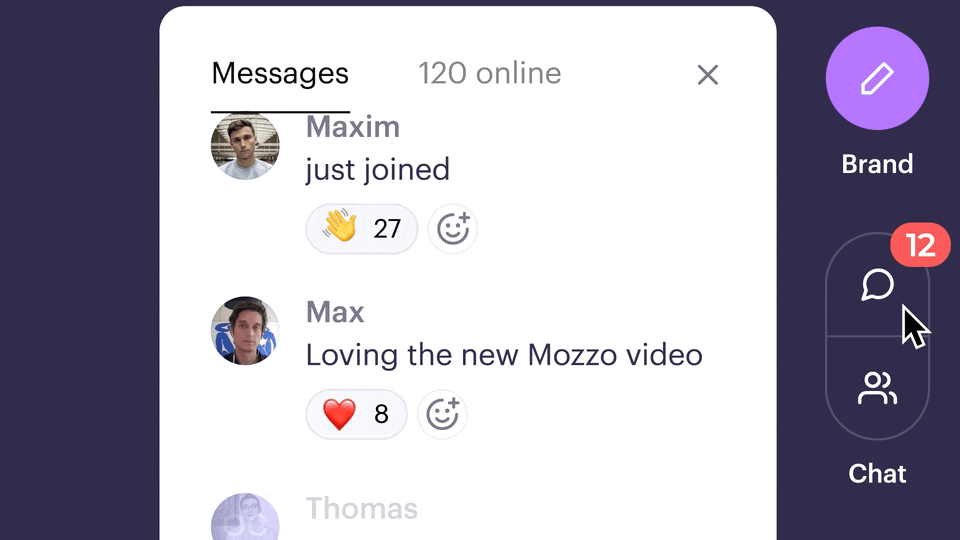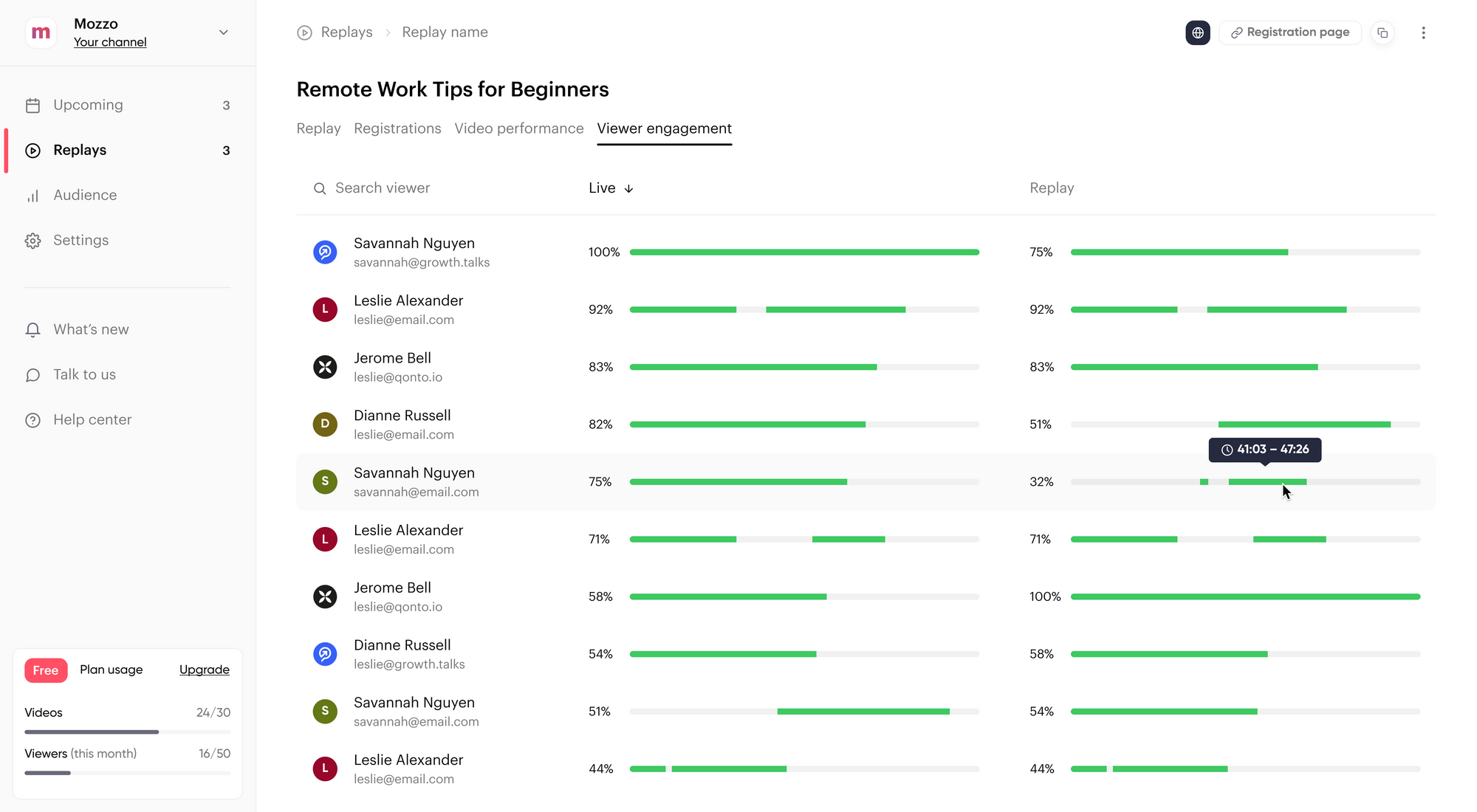Introduction
Understanding webinar metrics might feel like deciphering a foreign language. In 2021 alone, companies churned out over 100,000 hours of webinars — that's like hosting a webinar non-stop for more than ten years! Now, imagine the colossal mound of data waiting to be analyzed. But fret not. With this post, you’re about to uncover a secret source of power that can give you a leg up on your competitors, and it's hidden right there, in those metrics.
It’s time to sober up from the free-flowing data cocktail and instead, pick apart the precise elements that drive success. Welcome to the world of sophisticated shallowness, where diving deep into data analytics turns into a winning RSVPs game.
The Power of Webinar Engagement Metrics
TL;DR:
- Gain a solid grasp of engagement metrics and their crucial role in webinars.
- Identify the must-track metrics from polls to Q&A interactions.
- Discover how to leverage these metrics to hike your webinar performance.
Understanding Engagement Metrics: What They Are and Why They Matter
The secret sauce to any successful webinar isn't simply the content itself or the speaker's charisma. A significant part of it lies in mastering webinar analytics like engagement metrics. Engagement metrics, as the term suggests, help identify audience behavior. These are an array of data points that reflect attendees' interaction during webinars, offering insights into their interests, preferences, and engagement levels.
Armed with this data, hosts can pinpoint elements that resonated with the audience and those that didn't - areas that raised excitement, curiosity, and areas that led to increased distractions or drop-offs. In essence, it helps organizations foster meaningful connections, tailor future webinars, and significantly boost their ROI.
Key Engagement Metrics to Track: From Q&A Interactions to Polls
An array of engagement metrics reads like a goldmine of information. However, some are particularly pivotal in assessing webinar performance. Let's highlight a few:
Q&A Interactions
The number and nature of questions posed by the audience can be a valuable engagement indicator. Running a Q&A session at the end of the webinar can also help improve the other engagement metrics. It can also guide your content strategy for future webinars.

Attention Span/Interest Rate
This metric gauges how long attendees remain focused on the webinar content. Sharp declines may indicate a need for content revamp or improved webinar delivery.
Participation in Polls/Surveys
How many attendees take your polls or complete post-webinar surveys? This participation illuminates the effectiveness of these elements in sparking engagement and sheds light on attendees' thoughts and opinions.

Incorporating these measurements into your webinar strategy can offer a roadmap to pushing viewer engagement to new heights.
How to Leverage Engagement Metrics for Improved Webinar Performance
Engagement metrics aren't just about quantifying viewers' interactions during webinars. They're tools to leverage for improved performance and ROI.
Firstly, they can guide decisions on the content, design, presentation style, and the ideal duration for your webinars. If you find that attention spans dwindle in the latter half of your webinar, consider reworking your content flow or shortening your sessions.
Secondly, metrics like questions posed, most 'liked' or 'upvoted' webinar questions, poll results, and such can inform future sessions' content, helping you align better with your audience's interests and queries.
Lastly, consistently analyzing and acting upon these metrics over multiple webinars can help identify trends, predict behaviors, and allow organizations to maneuver their webinar strategy for maximum returns.
Each of these aspects underscores why paying attention to webinar engagement metrics isn't just beneficial – it's downright crucial for those eyeing a sturdy ROI from their webinar undertaking.


Easy Webinars With All the Metrics You Need Built-In
Start for free up to 30 registrants. No credit card needed.
Start for freeThe Role of Webinar Conversion Metrics in ROI Maximization
- Conversion Metrics act as a bridge between audience engagement and webinar return on investment (ROI).
- It's essential to monitor specific conversion metrics to optimize the success of your webinars.
- You can strategically boost conversion rates, thus improving overall webinar effectiveness.
Defining Conversion Metrics: The Bridge Between Engagement and ROI
Webinar conversion metrics are key performance indicators (KPIs) that measure the transformation from a passive audience member, to an engaged participant, to a customer. In broader terms, it represents the shift from interest to action. If we draw parallels to a physical store, conversion is akin to a window-shopper morphing into a paying client.
These metrics aren't strictly numeric. They capture the effectiveness of various aspects of a webinar- like content, presentation, and follow-up strategies - in prompting audiences to take the desired action. Analyzing the right data points can provide valuable insights into which components of the webinar funnel are working and which aren't, helping to enrich your webinar ROI.
Essential Conversion Metrics Every Webinar Host Should Monitor
Monitoring webinar conversion metrics equips hosts with a broader understanding of their audience's behavior and preferences. Some critical conversion metrics can revolutionize your webinar strategy:
Number of registrations
The first metric to monitor is the review of registered audience numbers. It gives an overview of potential participants and their interest level towards your webinar topic.
For companies using webinars to generate leads, registrants are often one of the most important metrics as they correspond to the number of new leads added to the CRM.
Attendance Rates
It's crucial to know how many registered participants attend the webinar. A gap between registrants and attendees reveals webinar timing issues — maybe you didn't pick the best day and time for your webinar. It can also be an indicator of lack of reminder emails.
Attendance rate % = (# of Attendees / # of Registrants) x 100
Replay View Rates
Not every one of your registrants will be able to make it to the live. Making your replay available on-demand and calculating replay view rates will give you a better indicator of the content consumption of your webinar by your audience. It's calculated similarly to Attendance Rates.
Adjusted Attendance rate % = (# of Attendees (Live or Replay) / # of Registrants) x 100
Attendee Engagement
Metrics like attendance time, participation in polls, or questions asked during Q&A sessions offer insights into audience engagement. A high engagement rate usually indicates quality content and effective presentation style.

CTA Click-Through Rates
Arguably the most critical conversion metric, the webinar CTA click-through rate measures the percentage of attendees who act on the prompted calls-to-action. It's the most direct indication of ROI.
Strategies to Boost Conversion Rates and Enhance Webinar Success
Harnessing conversion metrics effectively involves deploying strategies to boost these rates. Here are some useful tactics:
Create Compelling Content
Recognizable guest speakers and high-value content draw in registrations and keep attendees engaged. It's crucial to offer actionable insights and solutions to the audience's pain points to increase conversions.
Creating a catchy webinar title will also help drive more people to watch your live or replay.
Personalize Communication
Tailoring communications to the individual attendee - from invitation emails to follow-ups - fosters a connection, thus improving conversion chances.
Improve CTA Visibility
Ensure your CTAs are not going unnoticed. Strategically place them within the webinar and make them conspicuous in design and compelling in action.
Armed with these insights, the journey from interest to ROI becomes clearer and easier to navigate, paving the way for webinar success.
Why Webinar Attendance Metrics Matter
- Attendance metrics shed light on webinar performance and engagement.
- Prioritize attendance metrics such as registrations, attendees, and no-shows during analysis.
- Use these metrics to tweak and enhance your webinar strategy for boosted ROI.
The Significance of Attendance Metrics in Webinar Success
Webinar attendance metrics are not mere statistics; consider them the pulse of your online events. An understanding of your audience's behaviour and participation levels gives you a clear picture of your webinar performance.
For instance, high attendance might suggest your topics are relevant and your marketing efforts successful. Low attendance, on the other hand, may indicate a need for better webinar promotion, catchy topics or more suitable scheduling times. Therefore, attendance metrics serve as a thermometer, informing you about the health of your webinars and providing valuable insights into what is working and what needs improvement.
Attendance Metrics to Keep an Eye On: Registrations, Attendees, and No-Shows
When parsing attendance metrics, it is prudent to focus on three vital figures: registrations, attendees, and no-shows.
Registrations
This refers to the number of individuals who signed up to attend your webinar (registrants). It's an indicator interest level in your topic and the success of your promotional efforts.
Attendees
These are the individuals who actively participated in your webinar (attendees). High attendee numbers could suggest that your webinar's content and presentation style are effective and engaging.
No-shows
This group includes those who registered but failed to attend the webinar. A high no-show rate might suggest scheduling issues or a gap between people’s initial interest and their ultimate willingness to allocate time to your event.
Understanding these metrics can help you hone your strategy, improving your engagement levels and, ultimately, your ROI.
Using Attendance Metrics to Refine Your Webinar Strategy
The value of attendance metrics extends beyond their descriptive capabilities. With proper scrutiny, these figures can serve as a strategic tool to refine your webinar strategy.
By tracking registrations and attendees, you can measure true engagement levels and adjust your webinar content, timing, and promotional efforts accordingly. No-shows give you insights into audience behaviour patterns, or can be a signal that you need to improve your registration pages. Furthermore, tracking attendance metrics over time allows you to identify trends, providing you with an opportunity to address recurrent problems and reinforce successful strategies.
Where relevant, segment your attendance metrics by factors such as industry, role, and location. This can provide insights into who is most engaged, helping you tailor future webinars to appeal to these high-potential audiences better.
Attendance metrics are thus more than just numbers on a page; they are an avenue to understanding audience behaviour, increasing attendee numbers, and in turn, maximizing your webinar ROI.


Easy Webinars With All the Metrics You Need Built-In
Start for free up to 30 registrants. No credit card needed.
Start for freeWebinar ROI Metrics: The Ultimate Measure of Success
- Grasp the principles behind the fundamental ROI metrics related to webinars.
- Discover key metrics that promise a comprehensive performance view.
- Learn techniques to boost these metrics for your subsequent webinar events.
Understanding ROI Metrics: The Bottom Line of Your Webinar Efforts
Metrics are pivotal to trace performance and alter the course with refined strategies if necessary. It stands even truer in the case of webinars - digital events aiming to educate, engage, and convert prospects, calling for constant monitoring and evaluation of your efforts. But amidst a plethora of metrics and webinar best practices, the question projectors: Where to pin your focus? The answer lies in the most vital key performance indicator: your Return on Investment (ROI).
Your webinar's ROI is the ratio of net profit to the cost of investment. Essentially, it sums up the effectiveness of your webinar efforts and your success in meeting business objectives. Simply put, it's the cash return on every dollar spent on conducting a webinar. If you're seeing a positive ROI, your webinar was worth the time and resources invested. Whereas, a negative ROI indicates the need to re-evaluate your strategy.
Key ROI Metrics to Track for a Comprehensive Performance Overview
There's no one-size-fits-all approach to webinar metrics, but a set of key figures will garner a gist of your webinar's performance.
Cost per Lead
Calculates the expense incurred to acquire a lead through your webinar. The lower the cost, the better the ROI of your event. It is calculated by dividing the total cost from webinar marketing by the number of leads it generated.
Cost per Lead = Sum of Webinar Marketing Cost / # of Leads
Attendee-to-Lead Conversion
Tally the percentage of attendees who turned into later leads. High conversion suggests compelling content; a low figure implies the need for improvement.
Attendee-to-Lead Conversion = # of Leads / # of Attendees
Lead-to-Customer Conversion
Evaluates how many leads converted into paying customers. A solid measure of the effectiveness of your leads nurturing efforts post the webinar.
Lead-to-Customer Conversion = # of Customers / # of Leads
These numbers will provide a panoramic overview of how well your webinar is performing in monetary terms. Balance these conversion metrics to ascertain if you're spending the right amount on the right audience and whether those expenses resulting in customer acquisition and sales.
How to Improve ROI Metrics for Future Webinars
Improving your ROI means you're getting more bang for your buck. Here are strategies to ensure that:
- Target Audience: Pinpoint your target demographic and tailor your content to cater to their interests and needs.
- Engaging Content: Create compelling, high-quality content. The more engaging your webinar, the better the conversion rates.
- Promotion: Effectively promote your webinar through various channels to ensure maximum participation.
- Follow-up: A proactive follow-up strategy will help convert leads into customers.
- Channel analysis: Use UTM parameters to track your best marketing channels and determine where to double down on.
Remember, high ROIs are a product of constant review, learning, and improvement. Monitor your strategies, take actionable insights from past webinars, and modify your approach to always ensure a higher ROI on your future webinars.
Evaluating Your Webinar Performance Metrics
While webinar ROI metrics serve as the ultimate measure of success, an in-depth understanding of the performance metrics helps understand the details better.
- Performance metrics highlight the precise changes needed to improve webinar ROI
- Performance metrics are critical to optimize your webinar for increased participant engagement and improved ROI
- These metrics iteratively contribute to your webinars' continuous improvement
Choosing the Right Tool for Webinar Metrics
The best webinar platforms will give you the tools to measure all the metrics mentioned in this article. From registrations, attendee rates, conversion rates, watch time and engagement metrics.

The Importance of Performance Metrics in Webinar Evaluation
If webinars are a part of your marketing or training strategy, your focus should be on understanding its performance holistically. Performance metrics aren't about nitpicking individual issues, they're about catching a broad overview of how efficiently the webinar is progressing. They indicate the areas requiring immediate attention and tweaks to ensure the desired engagement and ROI.
Performance metrics are a powerful tool for webinar evaluation as they offer actionable insights. Each metric gives a clear picture of what works and what doesn’t, contributing significantly to webinar success.
Performance Metrics to Monitor for a Holistic Webinar Assessment
A comprehensive assessment of your webinar demands a collective look at a range of performance metrics. This includes registration rate, attendance rate, attendee engagement, content performance, and follow-up response.
Each of these plays a critical part in revealing a multifaceted view of your webinar's performance. For example, a high registration rate indicates interest, but low attendance may point to timing issues. Engagement metrics, on the other hand, provide insights into the content's perception and effectiveness. High on-demand views indicate that recording the webinar is key to maximising the number of content views for your webinar.
Understanding these metrics holistically helps in getting a clear picture of the issues and strengthens the planning for future webinars with improved prospects of success.
Using Performance Metrics to Drive Continuous Webinar Improvement
Performance metrics aren't merely for criticism or commendation; they serve as the stepping stones for continuous improvement. These can provide guidance on topics that resonate with your audience, the type of content that drives engagement, and the ideal participants' demographic.
Addressing the findings directly results in improved webinar hosting with an increasing ROI. For example, if a presentation style is showing higher engagement rates, adapting it into future webinars can boost overall ROI. Running fun virtual events might show higher engagement rates from specific audience segments — so doubling down on this could be powerful.
Benchmarking against these metrics and striving for improvement ensures gradual growth and positive returns. It's all about harnessing the insights from hard data to deliver webinars that genuinely engage, inform, and convert.
Unearthing Profits: Perfecting Your Webinar Performance
Webinars can serve as an untapped goldmine for business growth if conducted right and analysed thoroughly. Measuring the right metrics, from engagement rates to conversion rates, is key. When complemented with actionable insights, it can significantly boost ROI.
Don’t let data scare you. Instead, harness it to transform your webinars into a potent business tool. Start by defining your success metrics, then go a little deeper. Identify your audience personas, their behaviors during the event, and the factors triggering conversion.
Now, it's time to act. Are you ready to take a meticulous look at your webinars and unlock hidden opportunities? What specific metric will you focus on in your next webinar to maximize your ROI?
Remember, measurable results may not unfold instantly, but consistent analysis and adjustments can lead to astronomical growth. Stay persistent, keep perfecting, and watch your business skyrocket!
And don't forget to try Contrast for the easiest webinars with all the metrics you need in-built.


Easy Webinars With All the Metrics You Need Built-In
Start for free up to 30 registrants. No credit card needed.
Start for free